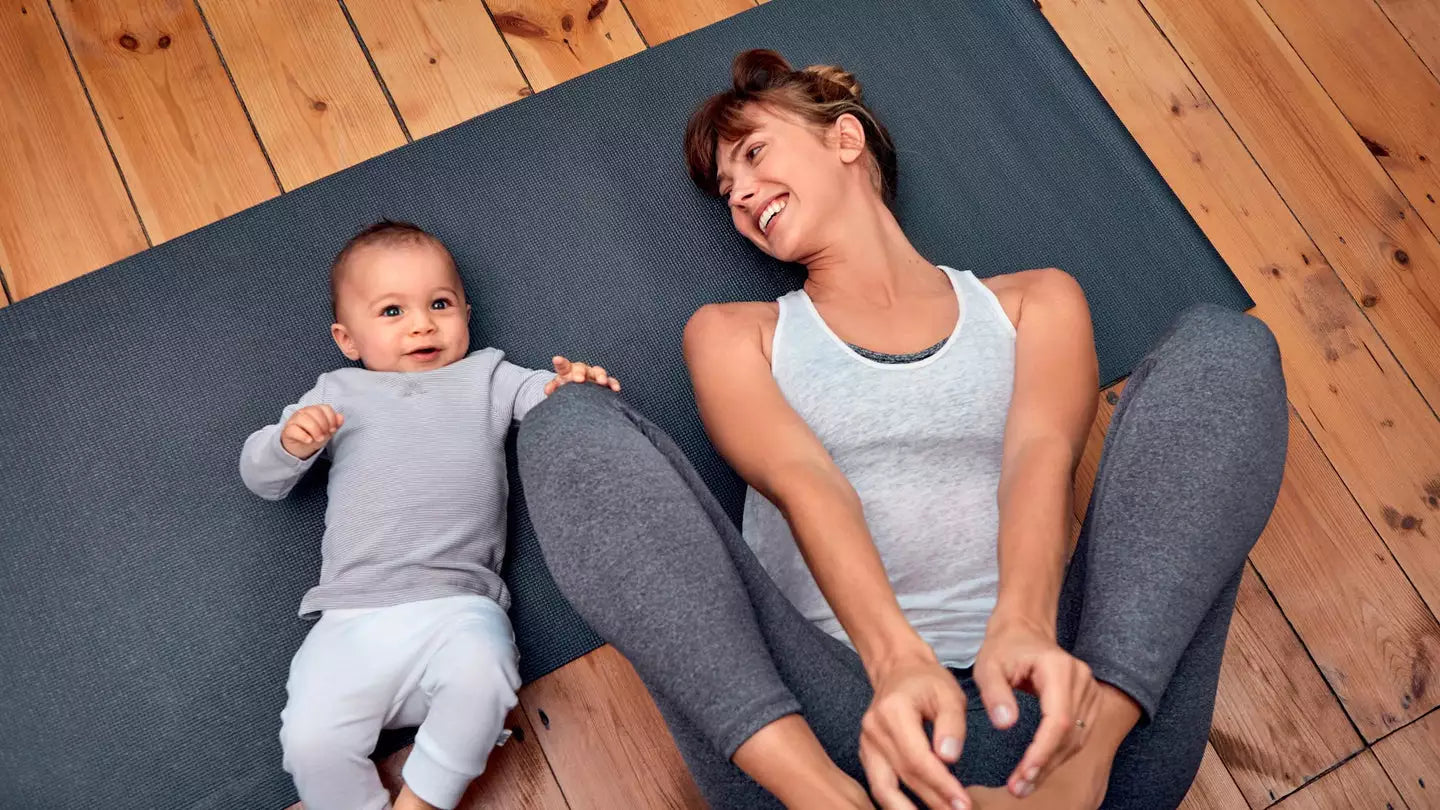From sitting up unaided to taking their first steps, baby's movement changes and develops daily. Here are the signals that show they’re on the way to achieving a physical milestone – and what you can do to help them on their way.
Seeing your baby achieve physical milestones can be one of the most exciting parts of parenting. Watching them learn to sit, roll, crawl and finally take those first wobbly steps will probably be proud moments you’ll remember forever.
But waiting for them to reach milestones can be a stressful process too, as you wonder why that little girl at playgroup’s been walking for three months while yours just sits on the carpet pointing at toys all day. Here’s the lowdown on what to expect from your baby’s physical development.
Before you think about when your baby will sit, crawl or walk remember…
It’s a bit of a childcare cliché but, no two babies are the same. Try not to compare your child’s progress directly to others – down that path lies only frustration. Paediatric occupational therapist and baby development expert Fiona O’Farrell explains: “When we talk about development, we’re talking about a range. Each child is different – some will acquire milestones faster and others slightly slower. The important thing is that the pattern of development is the same.

“There’s a lot of information out there for parents that sets expectations and makes things stressful because you're constantly thinking ‘is my baby achieving this?’ as opposed to looking at the whole process of development. We always talk about the visible markers like sitting and walking, but there are also prerequisites for these stages that often go under the radar.”
Look for less visible pointers
Those less visible developments begin right from the moment your baby is born. “By 10 weeks your baby should have developed good head control, beginning to turn their head and bring it back to the centre in a smooth, controlled movement,” Fiona says.
“That’s the first physical indicator of a prerequisite for your baby being able to sit.“The other physical stage that is often overlooked but is so important is being able to do tummy time. In the first few weeks it might just be on your chest, but the key is to engage with your baby. You could also do it when you’ve changed your baby. Just turn them over on the mat (always supervising them). Get in really close with your face, laughing and cooing. Maybe move your face away from your baby so they follow you and begin to move their head in different directions. You’re working on tummy time but you’re also working on head control for rolling, crawling and pulling up to stand.”
Baby's Movement: Sitting

When will my baby learn to sit?
“At around 4-6 months your baby will start to sit up,” says Fiona. “It’s really important that as a parent you allow them lots of time on the floor. We’re so busy now, we’re in and out of cars, putting babies in car seats and chairs. Try to get your baby down on to ground level as much as possible so that they can develop the strength they need to support themselves.”
How can I help my baby learn to sit?
To finesse this skill, a well-chosen toy can help. “Around this time your baby’s movements will begin to become more purposeful,” says Fiona. “A simple toy like a rainmaker can be used throughout all these developmental stages. So now you might sit your baby in a supported position and lift the rainmaker to eye level and down to the floor so they’re following the movement. That’s building up muscle control.”
Word of warning:
Learning to sit independently is a gradual process and your baby might still tumble after you think they’ve nailed it, so stick to soft surfaces until you’re really confident they won’t fall.
Baby's Movement: Rolling

When will my baby learn to roll over?
Once they’ve mastered sitting, it’s time to think about getting around. At about six months babies will have the strength to to roll over. If you see them lifting their head or reaching for objects while lying down, that’s a sign they might be ready.
How can I help my baby learn to roll over?
To encourage them at this stage, try getting down on the floor with your baby (oh, go on). Shaking an interesting toy just in front or to the side of them can help.
Learning to roll can happen suddenly and one little roll can have a lot of momentum! Don’t leave your baby unattended on a raised surface for this reason.
Word of warning:
Baby's Movement: Crawling

When will my baby learn to crawl?
You might see your baby master this skill at around 7-9 months. “Once babies develop the muscles to roll from side to side, they’re then developing the prerequisites to begin to crawl,” explains Fiona. “Everything is built upon the stage that went before.”
Other babies never crawl, getting around by bum-shuffling or going straight to walking instead. While opinion differs on whether non-crawlers miss out on essential skills, all experts agree on the importance of tummy time.
How can I help my baby learn to crawl?
When it comes to any physical activity, you need to pick your moment. “It’s so important that baby’s ready to engage,” Fiona explains. “If your baby’s tired or overstimulated it’s best not to try to play with them. Wait until they’re calm, rested and alert. It’s also about reading your baby’s cues. If they’re looking at you, you know they’re ready to engage.” So lay the schedule to one side and let yourself be guided by when your baby is open to learning.
Word of warning:
Once your baby’s crawling, there’s a good chance they’ll be into anything and everything at lightning speed. Childproof your home BEFORE they crawl – the best way to do this is by getting down on your hands and knees and taking a tour from a baby’s eye view.

"Our daughter never crawled. I did worry a little bit at the time but I knew from early on that her skills were more mental than physical. She bum-shuffled for a while and then walked when she was ready. Now she’s three, the fact that she never crawled has made absolutely no difference!”
Alex, 42, London
Baby's Movement: Walking

When will my baby learn to walk?
“Often parents will say ‘so-and-so’s walking at 11 months, but mine’s 15 months and still hasn’t mastered it,” says Fiona. “Again, there’s a range of development. The average will be 16 months, but if your baby’s pulling up to stand and beginning to step around furniture, then you know they’re developing those prerequisite skills to walking and it’s only a matter of time.” A 2013 study found no link between early walking and future ability, so don’t read too much into your baby’s first steps.
How can I help my baby learn to walk?
Once you baby can stand, hold their hands to help them practice walking (it can feel a bit back-breaking after a while, so be conscious of how you’re holding yourself when doing it). When they’ve learned to cruise from wall to furniture using their hands for support, place a trail of helpful objects for them to follow across a room.
Word of warning:
Once kids start walking it’s hard to contain them. If you haven’t already, it’s time to install gates to stop them attempting the stairs. Any low table edges should also be covered to stop your baby bumping their head.

“Coco walked at 9.5 months. She’d been crawling for about a week and decided that wasn’t enough for her! From her first wobbly little steps I can remember the look of fierce determination on her face and how happy and proud she was of herself. In our last Baby Sensory class when I was feeling super emotional, Coco got up, waddled over to the other side of the circle and sat on another mum’s lap for the last song!”
Clare, 28, Leigh-on-Sea
Baby's Movement: Dancing

Somewhere around 16-20 months, the day will finally arrive when you can put on a Katy Perry megamix and throw some serious shapes with your toddler. Make sure you take time to appreciate how much skill this requires on their part. “Dancing involves a lot of weight-bearing skills,” explains Fiona. “It’s a fantastic development in terms of strength and coordination. It’s also about developing an interest in music. Even before they’re born, play music to your baby in the womb – it helps stimulate the senses.”
Running, jumping and… freedom:
From about 18 months onwards, things will pick up a notch and your toddler may start to master running (although they’ll probably be limited to straight lines until around two years old) and jumping. Watching a three-year-old learn to hop definitely ranks among the most amusing sights of parenthood. The best thing you can do for your growing explorer at this stage is to get out into parks and open spaces and let them enjoy their own freedom of movement. Swinging, spinning, rolling and leaping – it’s all on the menu now. Whether you join in yourself or find a convenient viewing bench and a good takeaway coffee, we leave up to you.
Should I be worried if my baby's movement isn't developing?
If you’re worried about any element of your baby’s development, Fiona advises you to look at the bigger picture. If your baby’s generally showing signs of readiness to move onto their next milestone and is progressing through skills in the right order, it’s probably just a matter of time. But if your baby is behind on all their milestones and doesn’t seem to be developing the muscle strength and coordination they need, that might indicate a problem. If you’re concerned, speak to your doctor or health visitor.

“At Violet’s first birthday party she enjoyed her newfound independence, happily bowling around greeting guests, delighted to be allowed cake! The only thing she needed help with was blowing out the candle – her brother was only too happy to oblige.”
Gemma, 35, Southampton
Now you know when to expect baby's movement milestones, it might be worth understanding when they're going to start speaking their mind too.
Read Our Guide to Baby's Speech













